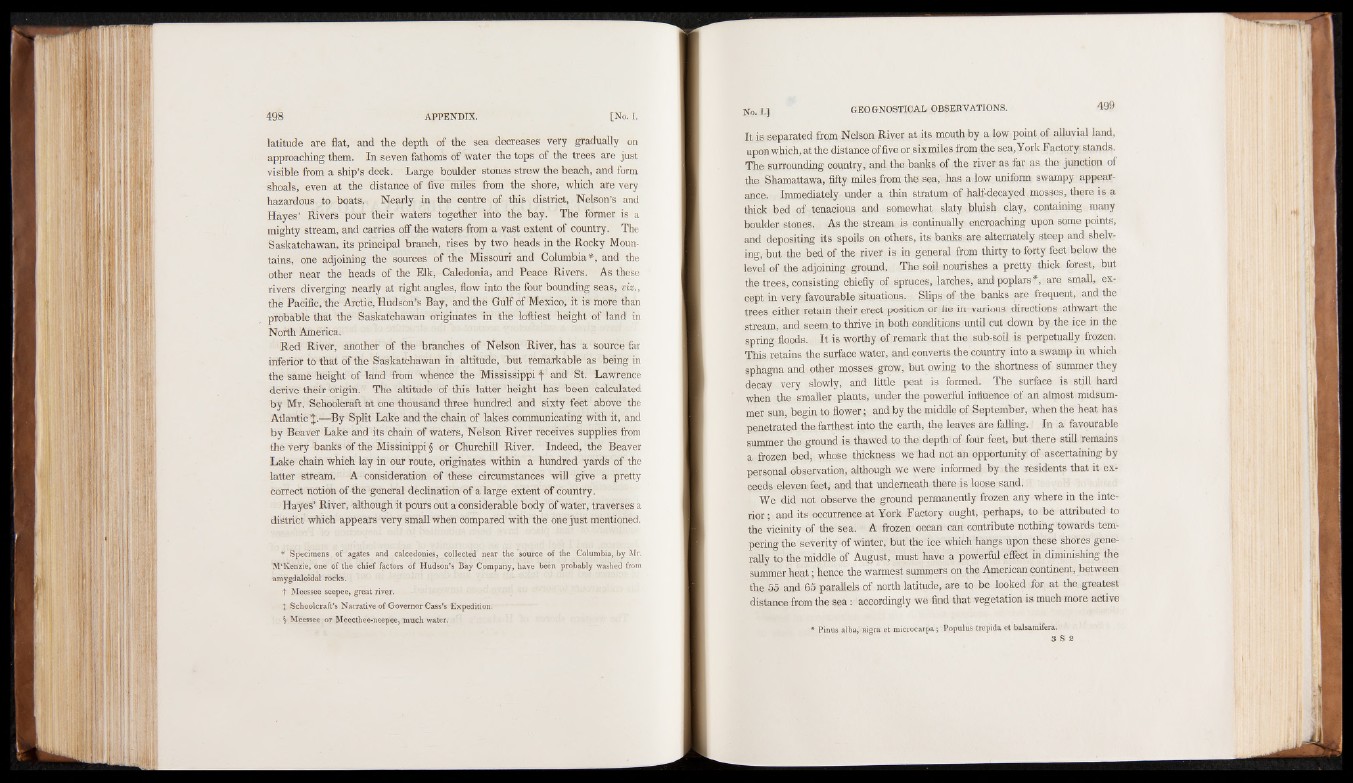
latitude are flat, and the depth of the sea decreases very gradually on
approaching them. In seven fathoms of water the tops of the trees are just
visible from a ship’s deck. Large boulder stones strew the beach, and form
shoals, even at the distance of five miles from the shore, which are very
hazardous to boats. Nearly in the centre of this district, Nelson’s and
Hayes’ Rivers pour their waters together into the bay. The former is a
mighty stream, and carries off the waters from a vast extent of country. The
Saskatchawan, its principal branch, rises by two heads in the Rocky Mountains,
one adjoining the sources of the Missouri and Columbia*, and the
other near the heads of the Elk, Caledonia, and Peace Rivers. As these
rivers diverging nearly at right angles, flow into the four bounding seas, viz.,
the Pacific, the Arctic, Hudson’s Bay, and the Gulf of Mexico, it is more than
probable that the Saskatchawan originates in the loftiest height of land in
North America.
Red River, another of the branches of Nelson River, has a Source far
inferior to that of the Saskatchawan in altitude, but remarkable as being in
the same height of land from whence the Mississippi j- and St. Lawrehce
derive their origin. The altitude of this latter height has been calculated
by Mr. Schoolcraft at one thousand three hundred and sixty feet above the
Atlantic '];.—By Split Lake and the chain of lakes communicating with it, and
by Beaver Lake and its chain of waters, Nelson River receives supplies from
the very banks of the Missinippi § or Churchill River. Indeed, the Beaver
Lake chain which lay in our route, originates within a hundred yards of the
latter stream. A consideration of these circumstances will give a pTetty
correct notion of the general declination of a large extent of country.
Hayes’ River, although it pours out a considerable body of water, traverses a
district which appears very small when compared with the ofte just mentioned. *§
* Specimens , of agates and calcedonies, collected near the source of the Columbia, by Mr.
M‘Kenzie, one of the chief factors of Hudson’s Bay Company, have been probably washed from
amygdaloidal rocks,
t Meessee seepee, great river.
X Schoolcraft’s Narrative of Governor Cass’s Expedition.
§ Meessee or Meecthee-neepee, much water.
It is separated from Nelson River at its mouth by a low point of alluvial land,
upon which, at the distance of five or.sixmiles from the sea, York Factory stands.
The surrounding country, and the banks of the river as far as the junction of
the Shamattawa, fifty miles from the sea, has a low uniform swampy appearance.
Immediately under a thin stratum of half-decayed mos.ses, there is a
thick bed of tenacious and somewhat slaty bluish clay, containing many
boulder stones. As the stream is continually encroaching upon some points,
and depositing its spoils on others, its banks are alternately steep and shelving,
but the bed of the river is in general from thirty to forty feet below the
level of the adjoining ground. The soil nourishes a pretty thick forest, but
the trees, consisting chiefly of spruces* larches, and poplars*, are small, except
in very favourable situations. . Slips of the banks are frequent, and the
trees either retain their erect position or lie in various directions athwart the
stream, and seem_to thrive in both conditions until cut down by the ice in the
spring floods. It is worthy of remark that the sub-soil is perpetually frozen.
This retains the surface water, and converts the country into a swamp in which
sphagna and other mosses grow, but owing to the shortness of summer they
decay very slowly, and little peat is formed. The surface is still hard
when the smaller plants, under the powerful influence of an almost midsummer
sun, begin to flower; and by the middle of September, when the heat has
penetrated the farthest into the earth, the leaves are falling. In a. favourable
summer the ground is thawed to the depth of four feet, but there still remains
a frozen bed, whose thickness we had not an opportunity of ascertaining by
personal observation, although we were informed by the residents that it exceeds
eleven feet, and that underneath there is loose sand.
We did not observe the ground permanently frozen any where in the interior;
and its occurrence at York Factory ought, perhaps, to be attributed to
the vicinity of the sea. A frozen ocean can contribute nothing towards tempering
the severity of winter, but the ice which hangs upon these shores generally
to the middle of August, must have a powerful effect in diminishing the
summer heat; hence the warmest summers on the American continent, between
the 55 and 65 parallels of north latitude, are to be looked for at the greatest
distance from the sea: accordingly we find that vegetation is much more active
♦ Pinus alba, nigra et microcarpa; Populus trepida et balsamifera.